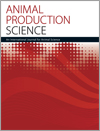
Animal Production Science
Volume 62 Number 6 2022
AN21086Maternal influence on the skewing of offspring sex ratio: a review
 , Sellappan Selvaraju, B Krishnan Binsila, Ippala Janardhan Reddy, Janivara Parameshwaraiah Ravindra and Raghavendra Bhatta
, Sellappan Selvaraju, B Krishnan Binsila, Ippala Janardhan Reddy, Janivara Parameshwaraiah Ravindra and Raghavendra Bhatta
Sex pre-selection is the key area of interest as it aids in greatly increasing the efficiency and profitability of the farmers and livestock enterprise. Sex pre-selection through maternal diet alteration is clearly a reliable and cost-effective approach to allow the livestock industry to control the sex ratio of their domesticated animals. However, elucidating the mechanism associated with the skewing of offspring sex ratio is necessary to study and understand in large scale.
Intestinal health consists of several components, among which is the barrier function, which isolates the animal from the external environment, and its pathological and health challenges. Therefore, the identification of the intestinal barrier function, during the weaning period, is of most importance in pig production. Furthermore, this research reflects the advantages of weaning piglets at late ages and implementing alternatives to the use of growth-promoting antibiotics.
AN21249Maternal oral supplementation with citrulline increases plasma citrulline but not arginine in pregnant Merino ewes and neonatal lambs
 , Billie-Jaye Brougham, Alyce M. Swinbourne, Alice C. Weaver, Jennifer M. Kelly, Kathryn L. Gatford, David O. Kleemann and William H. E. J. van Wettere
, Billie-Jaye Brougham, Alyce M. Swinbourne, Alice C. Weaver, Jennifer M. Kelly, Kathryn L. Gatford, David O. Kleemann and William H. E. J. van Wettere 
Arginine is an amino acid that can decrease lamb mortality by improving placental blood flow and increasing birth weight, however, it requires protection from degradation in the rumen. Our research demonstrated that feeding ewes with citrulline, an arginine precursor that does not require rumen protection, increased plasma concentrations of maternal and neonatal lamb citrulline, but not arginine. Further research into feeding pregnant ewes with citrulline is required to elucidate potential benefits to lamb survival.
Improvement in energy efficiency of cow–calf systems could benefit beef production sustainability, with ∼65% of consumed energy for beef production required by the cow herd. Energy efficiency has been associated with mitochondrial function. Greater cow–calf efficiency was associated with a greater hepatic mitochondrial density, without differences in mitochondria function, which likely explains a greater efficiency in hepatic nutrient metabolism.
Mineralisation of the bone matrix is a pivotal factor affecting bone strength in broilers. The findings of the current study showed that feeding reduced-protein diets increased ileal mineral digestibility but mineral concentrations in the tibia and femur of birds fed these diets were not different from those of birds fed the standard-protein diets. This information may help expand the adoption of reduced-protein diets in the poultry industry.
High energy-rich supplementation is being practised by the poultry producers for early growth and improved performance of chickens; however, they are unaware of adverse effects of excess dietary fat which alters the energy protein ratio in poultry and causes metabolic diseases e.g. fatty liver syndrome. The quercetin effectively protects against the high- energy diet-induced metabolic alteration in broilers and can be considered as the growth promoter phytoadditive with a strong antioxidant and lypolytic activity.
Commercial ducks are often housed in sheds with limited environmental control and can often experience high ambient temperatures in summer that adversely affects performance. A range of nutritional strategies was provided when Pekin ducks were exposed daily to a 9 h high-temperature challenge during Days 29–41 of age. Of the strategies examined, the provision of water supplemented with electrolytes and betaine supported the best liveweight gain.
AN21337 Abstract | AN21337 Full Text | AN21337PDF (968 KB) Open Access Article
Commercial production of foods for human consumption often generates byproducts that are traditionally wasted but contain significant levels of beneficial nutrients. This study aimed to investigate the nutritional potential of waste rosella pods, including an assessment of their digestibility in beef cattle. The material was found to be rich in antioxidants, phenolics, and several minerals, and to have comparable digestibility to other common fodders while delivering significantly greater antioxidant capacity during in vitro fermentation than feedlot rations.
AN21426Carcass characteristics, colour and eating quality of beef from late maturing suckler bulls finished at pasture with or without concentrate supplementation or indoors on a high concentrate ration
 , E. G. O’Riordan, M. McGee, M. G. O’Sullivan, J. P. Kerry, S. S. Wilson, F. J. Monahan
, E. G. O’Riordan, M. McGee, M. G. O’Sullivan, J. P. Kerry, S. S. Wilson, F. J. Monahan  , A. K. Kelly, K. McMenamin and L. Moran
, A. K. Kelly, K. McMenamin and L. Moran 
Their growth and feed efficiency advantages make bull beef production systems attractive alternatives for producers of steer beef. Data from the present study indicate that grazing suckler bulls for 199 days before slaughter does not negatively affect the eating quality of beef when compared to beef from bulls finished indoors on concentrates and grass silage despite a lower carcass fatness. There is an opportunity for suckler bull producers to access the growing market for ‘grass-fed’ beef.



